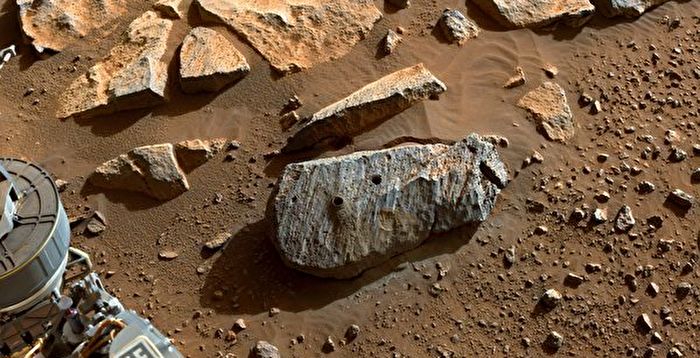[Epoch Times September 18, 2021](Epoch Times reporter Di Rui compiled a report) NASA scientists analyzed the latest rock samples drilled by the Perseverance Mars rover and found that they had Have been in contact with water for a long time. This provides the latest evidence for the claim that there was life on Mars.
Ken Farley, a scientist involved in the Perseverance project, said in a press release: “It seems that the first rock samples we drilled indicate that Mars once had a habitable environment. Test results show that there was a long period of time. There is water in it, and this discovery is of great significance.”
Perseverance is a six-wheeled mobile rover. After successfully landing on Mars in February this year, it began its exploration work. After the failure of the first rock sample drilling operation in August, the first rock sample was successfully collected on September 6, and the second rock sample was collected on September 8.
The two rock samples are slightly thicker than the pencil in diameter, about 6 cm long, and are sealed in a tubular container.
Perseverance is located in the Jezero Crater (Jezero Crater) north of the Martian equator. A lot of evidence has shown that there was a lake in this area 3.5 billion years ago, when the climate of Mars was much warmer and wetter than it is now.
NASA geologist Katie Stack Morgan said at a press conference: “An interesting clue revealed by these rocks is that they have been in contact with groundwater for a long time.”
Although scientists know that there was a lake in the impact crater before, they are not clear about its nature. If it is just a temporary puddle, which disappears after only 50 years, then there is little chance of life on it. If this pit is a lake supported by a groundwater system for a long time, the possibility of life is much greater.
Morgan said: “If these rocks are in a watery environment for a long time, there may be habitable cavities in the rocks, and there may have been microorganisms.” From the test results of this rock sample, there is water in the impact crater. The situation is the latter.
They speculate that the salt minerals in these rocks may lock some blisters from ancient times on Mars. “On Earth, salt minerals are good materials for preserving life in ancient times, and we estimate that it may be the same on Mars,” Morgan said. But this requires the sample to be taken back to Earth to be able to carry out these tests.
In addition, the main component of the two rock samples collected this time is basalt, which is probably the stone formed after the magma has cooled. The volcanic rock contains a lot of crystallized minerals, which is convenient for tracing the age of its formation by radioactive dating.
This will further help scientists explore the geological history of the impact crater, such as when it was formed, when the lake inside dried up and disappeared, and how the climate there has undergone changes. These explorations can only be carried out if the earth is retrieved.
NASA is planning to cooperate with the European Space Agency (ESA) to retrieve these samples back to Earth around 2030 at the earliest. Use more sophisticated instruments in the ground environment to detect, and then these rocks will provide more information about the history of Mars. ◇
Editor in charge: Ye Ziwei#
.
